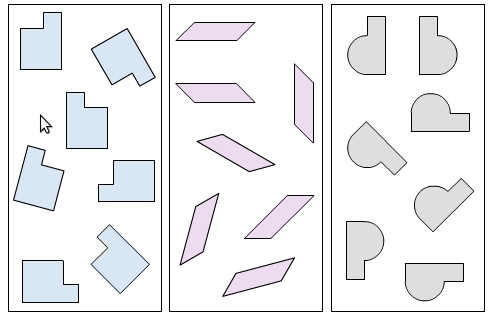Andrew Wilson
University of Edinburgh
Applicable Mathematics (Foundation) af0
- 1: Greek Geometry
- 2: Co-ordinate geometry
- 3: Trigonometry I
- 4: Quadratics
- 5: Circles
- 6: Trigonometry II
- 7: Polynomials
- 8: Sequences & Recurrence Relations
Applicable Mathematics (Foundation) af0
1: Greek Geometry
- Pythagoras theorem
- geometric demonstration of expansion of `(x+y)^2`
- methodology (proof)
- revision of expansion of brackets algebraically
- concepts of congruence and similarity
Applicable Mathematics (Foundation) af0
1: Greek Geometry

Applicable Mathematics (Foundation) af0
1: Greek Geometry

1.1 Pythagoras Theorem
In any right-angled triangle the side lengths satisfy
- `x^2 + y^2 = z^2`
Example
What is the exact length of `AB` and what is the length to 2 d.p.
`AB^2 = 8^2+3^2 = 64+9=73`
So `AB = sqrt(73) quad quad `(exact length)
and `AB=8.54 quad quad` (2d.p.)
Proof of Pythagoras Theorem
Unshaded area in the two diagrams is the same
So `z^2 = x^2 + y^2`
1.2 Algebraic aside
Unshaded area in the two diagrams is different!
So `x^2 + y^2` is different to `(x+y)^2`
Algebraic explanation
Formula is `(x+y)^2 = x^2+2xy+y^2` `quad quad (**)`
Can show this is the case by expanding `(x+y)^2`
- LHS` = (x+y)^2 = (x+y)(x+y)`
- `=x(x+y)+y(x+y)`
- `=x^2+xy+yx+y^2`
- `=x^2+2xy+y^2 = ` RHS
RHS of `(**)` is called the expansion of `(x+y)^2`
Useful formula `(a-b)(a+b)=a^2-b^2` `quad quad (** **)`
Explanation:
- `(a-b)(a+b)=a(a+b)-b(a+b)`
- `=a^2+ab-ba-b^2`
- `=a^2-b^2`
Exercise
- Check `(** **)` when `a=5` and `b=4`
- Expand `(x-6)(x+6)`
1.3 Geometric Aside
Area of a triangle `= 1/2 ("base" times "height")`
Reason
True for right-angled triangle because its area is `1/2 times "area of rectangle"`.
But any triangle can be split into two right angled triangles.
- So area of triangle
- `= 1/2 ah + 1/2bh =1/2(a+b)h`
- `=1/2("base" times "height")`
1.4 Similarity and Congruence
Two figures (e.g. squares, triangles, diagrams, etc.) are similar if one is just a scaled up version of the other.

For example, in each box to the right the shapes are similar to each other.
Similar figures have the same shape but differ in size.
Corresponding sides scale up or down by the same proportions.
Similar Triangles
The triangles `ABC` and `DEF` are similar if, and only if, the angles are the same.
Then we have
- `AB = k times DE`
- `BC = k times EF`
- `AC = k times DF`
where `k` is the scaling factor.
Example
Triangles `ABC` and `ADE` are similar.
- If the length of AD is `12` cm, find the length of `DE`.
- If `Ahat(C)B = 60^circ` what is `Ahat(E)D`.
- Since they are similar `AB=k times AD` and `BC= k times DE`. So`k = frac(AB)(AD) = frac(9)(12) = frac(3)(4)` and `6 = frac(3)(4) times DE`. Thus, `DE = frac(24)(3) = 8` cm
- `Ahat(C)B = 60^circ` tells us that `Ahat(E)D = 60^circ`.
Exercises
`ABCD` and `PQRS` are similar rectangles.
- Find the length of `RS`.
- Write down the length of `QP`.
Triangles `ADE` and `ABC` are similar. Find the length of `AB`.
Triangles `ABC` and `ADE` are similar. Find the length of `AC`.
Congruence
Two figures are congruent if they are the same apart from their positioning in the plane i.e. they are similar with scaling factor `1`.

For example, in each box to the right the shapes are congruent to each other.
Congruence
Example
A diagonal of a parallelogram divides the parallelogram into two triangles which
are congruent to each other.
Exercise: True or False?
- 1. All squares are congruent.
- 2. All circles are similar.
- 3. Angles in similar shapes are always the same.
- 4. All pairs of similar shapes are congruent.